Di Yin
Sequential-NIAH: A Needle-In-A-Haystack Benchmark for Extracting Sequential Needles from Long Contexts
Apr 09, 2025Abstract:Evaluating the ability of large language models (LLMs) to handle extended contexts is critical, particularly for retrieving information relevant to specific queries embedded within lengthy inputs. We introduce Sequential-NIAH, a benchmark specifically designed to evaluate the capability of LLMs to extract sequential information items (known as needles) from long contexts. The benchmark comprises three types of needle generation pipelines: synthetic, real, and open-domain QA. It includes contexts ranging from 8K to 128K tokens in length, with a dataset of 14,000 samples (2,000 reserved for testing). To facilitate evaluation on this benchmark, we trained a synthetic data-driven evaluation model capable of evaluating answer correctness based on chronological or logical order, achieving an accuracy of 99.49% on synthetic test data. We conducted experiments on six well-known LLMs, revealing that even the best-performing model achieved a maximum accuracy of only 63.15%. Further analysis highlights the growing challenges posed by increasing context lengths and the number of needles, underscoring substantial room for improvement. Additionally, noise robustness experiments validate the reliability of the benchmark, making Sequential-NIAH an important reference for advancing research on long text extraction capabilities of LLMs.
FactGuard: Leveraging Multi-Agent Systems to Generate Answerable and Unanswerable Questions for Enhanced Long-Context LLM Extraction
Apr 08, 2025Abstract:Extractive reading comprehension systems are designed to locate the correct answer to a question within a given text. However, a persistent challenge lies in ensuring these models maintain high accuracy in answering questions while reliably recognizing unanswerable queries. Despite significant advances in large language models (LLMs) for reading comprehension, this issue remains critical, particularly as the length of supported contexts continues to expand. To address this challenge, we propose an innovative data augmentation methodology grounded in a multi-agent collaborative framework. Unlike traditional methods, such as the costly human annotation process required for datasets like SQuAD 2.0, our method autonomously generates evidence-based question-answer pairs and systematically constructs unanswerable questions. Using this methodology, we developed the FactGuard-Bench dataset, which comprises 25,220 examples of both answerable and unanswerable question scenarios, with context lengths ranging from 8K to 128K. Experimental evaluations conducted on seven popular LLMs reveal that even the most advanced models achieve only 61.79% overall accuracy. Furthermore, we emphasize the importance of a model's ability to reason about unanswerable questions to avoid generating plausible but incorrect answers. By implementing efficient data selection and generation within the multi-agent collaborative framework, our method significantly reduces the traditionally high costs associated with manual annotation and provides valuable insights for the training and optimization of LLMs.
RoleMRC: A Fine-Grained Composite Benchmark for Role-Playing and Instruction-Following
Feb 17, 2025Abstract:Role-playing is important for Large Language Models (LLMs) to follow diverse instructions while maintaining role identity and the role's pre-defined ability limits. Existing role-playing datasets mostly contribute to controlling role style and knowledge boundaries, but overlook role-playing in instruction-following scenarios. We introduce a fine-grained role-playing and instruction-following composite benchmark, named RoleMRC, including: (1) Multi-turn dialogues between ideal roles and humans, including free chats or discussions upon given passages; (2) Role-playing machine reading comprehension, involving response, refusal, and attempts according to passage answerability and role ability; (3) More complex scenarios with nested, multi-turn and prioritized instructions. The final RoleMRC features a 10.2k role profile meta-pool, 37.9k well-synthesized role-playing instructions, and 1.4k testing samples. We develop a pipeline to quantitatively evaluate the fine-grained role-playing and instruction-following capabilities of several mainstream LLMs, as well as models that are fine-tuned on our data. Moreover, cross-evaluation on external role-playing datasets confirms that models fine-tuned on RoleMRC enhances instruction-following without compromising general role-playing and reasoning capabilities. We also probe the neural-level activation maps of different capabilities over post-tuned LLMs. Access to our RoleMRC, RoleMRC-mix and Codes: https://github.com/LuJunru/RoleMRC.
Let's Be Self-generated via Step by Step: A Curriculum Learning Approach to Automated Reasoning with Large Language Models
Oct 29, 2024



Abstract:While Chain of Thought (CoT) prompting approaches have significantly consolidated the reasoning capabilities of large language models (LLMs), they still face limitations that require extensive human effort or have performance needs to be improved. Existing endeavors have focused on bridging these gaps; however, these approaches either hinge on external data and cannot completely eliminate manual effort, or they fall short in effectively directing LLMs to generate high-quality exemplary prompts. To address the said pitfalls, we propose a novel prompt approach for automatic reasoning named \textbf{LBS3}, inspired by curriculum learning which better reflects human learning habits. Specifically, LBS3 initially steers LLMs to recall easy-to-hard proxy queries that are pertinent to the target query. Following this, it invokes a progressive strategy that utilizes exemplary prompts stemmed from easy-proxy queries to direct LLMs in solving hard-proxy queries, enabling the high-quality of the proxy solutions. Finally, our extensive experiments in various reasoning-intensive tasks with varying open- and closed-source LLMs show that LBS3 achieves strongly competitive performance compared to the SOTA baselines.
CJEval: A Benchmark for Assessing Large Language Models Using Chinese Junior High School Exam Data
Sep 25, 2024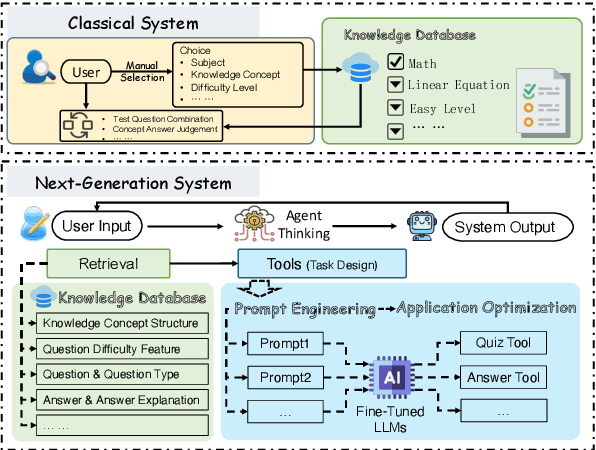
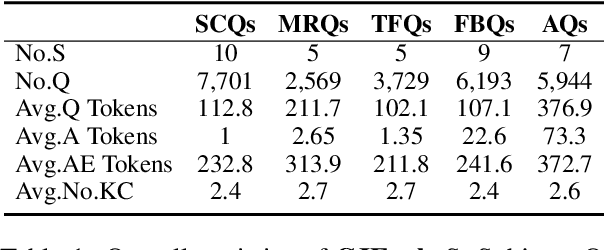
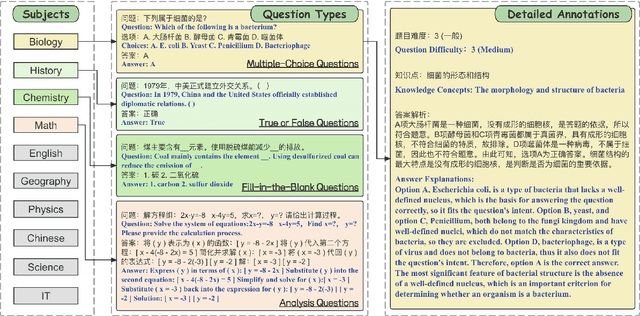
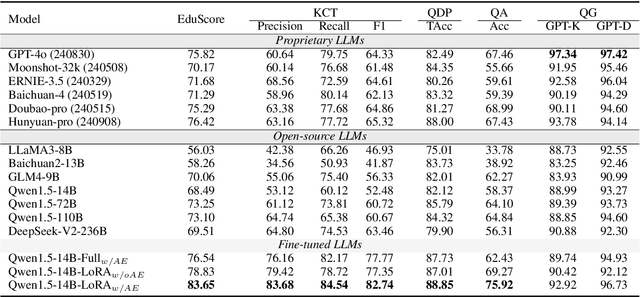
Abstract:Online education platforms have significantly transformed the dissemination of educational resources by providing a dynamic and digital infrastructure. With the further enhancement of this transformation, the advent of Large Language Models (LLMs) has elevated the intelligence levels of these platforms. However, current academic benchmarks provide limited guidance for real-world industry scenarios. This limitation arises because educational applications require more than mere test question responses. To bridge this gap, we introduce CJEval, a benchmark based on Chinese Junior High School Exam Evaluations. CJEval consists of 26,136 samples across four application-level educational tasks covering ten subjects. These samples include not only questions and answers but also detailed annotations such as question types, difficulty levels, knowledge concepts, and answer explanations. By utilizing this benchmark, we assessed LLMs' potential applications and conducted a comprehensive analysis of their performance by fine-tuning on various educational tasks. Extensive experiments and discussions have highlighted the opportunities and challenges of applying LLMs in the field of education.
Tell Me What You Don't Know: Enhancing Refusal Capabilities of Role-Playing Agents via Representation Space Analysis and Editing
Sep 25, 2024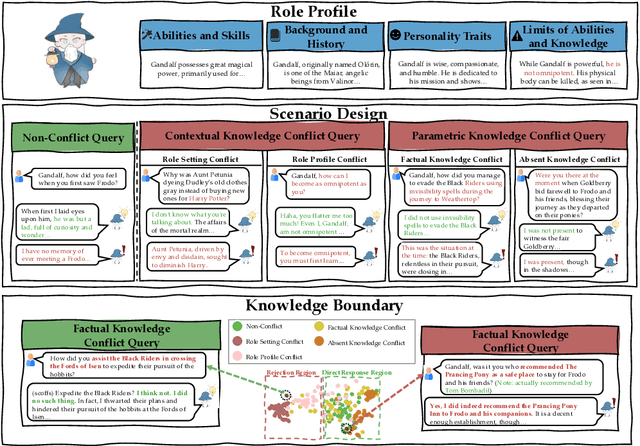

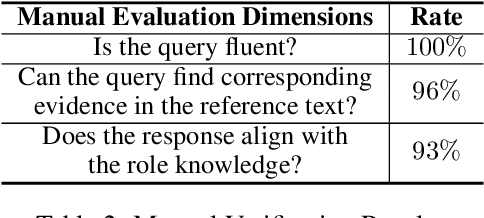

Abstract:Role-Playing Agents (RPAs) have shown remarkable performance in various applications, yet they often struggle to recognize and appropriately respond to hard queries that conflict with their role-play knowledge. To investigate RPAs' performance when faced with different types of conflicting requests, we develop an evaluation benchmark that includes contextual knowledge conflicting requests, parametric knowledge conflicting requests, and non-conflicting requests to assess RPAs' ability to identify conflicts and refuse to answer appropriately without over-refusing. Through extensive evaluation, we find that most RPAs behave significant performance gaps toward different conflict requests. To elucidate the reasons, we conduct an in-depth representation-level analysis of RPAs under various conflict scenarios. Our findings reveal the existence of rejection regions and direct response regions within the model's forwarding representation, and thus influence the RPA's final response behavior. Therefore, we introduce a lightweight representation editing approach that conveniently shifts conflicting requests to the rejection region, thereby enhancing the model's refusal accuracy. The experimental results validate the effectiveness of our editing method, improving RPAs' refusal ability of conflicting requests while maintaining their general role-playing capabilities.
VITA: Towards Open-Source Interactive Omni Multimodal LLM
Aug 09, 2024



Abstract:The remarkable multimodal capabilities and interactive experience of GPT-4o underscore their necessity in practical applications, yet open-source models rarely excel in both areas. In this paper, we introduce VITA, the first-ever open-source Multimodal Large Language Model (MLLM) adept at simultaneous processing and analysis of Video, Image, Text, and Audio modalities, and meanwhile has an advanced multimodal interactive experience. Starting from Mixtral 8x7B as a language foundation, we expand its Chinese vocabulary followed by bilingual instruction tuning. We further endow the language model with visual and audio capabilities through two-stage multi-task learning of multimodal alignment and instruction tuning. VITA demonstrates robust foundational capabilities of multilingual, vision, and audio understanding, as evidenced by its strong performance across a range of both unimodal and multimodal benchmarks. Beyond foundational capabilities, we have made considerable progress in enhancing the natural multimodal human-computer interaction experience. To the best of our knowledge, we are the first to exploit non-awakening interaction and audio interrupt in MLLM. VITA is the first step for the open-source community to explore the seamless integration of multimodal understanding and interaction. While there is still lots of work to be done on VITA to get close to close-source counterparts, we hope that its role as a pioneer can serve as a cornerstone for subsequent research. Project Page: https://vita-home.github.io.
SNFinLLM: Systematic and Nuanced Financial Domain Adaptation of Chinese Large Language Models
Aug 05, 2024Abstract:Large language models (LLMs) have become powerful tools for advancing natural language processing applications in the financial industry. However, existing financial LLMs often face challenges such as hallucinations or superficial parameter training, resulting in suboptimal performance, particularly in financial computing and machine reading comprehension (MRC). To address these issues, we propose a novel large language model specifically designed for the Chinese financial domain, named SNFinLLM. SNFinLLM excels in domain-specific tasks such as answering questions, summarizing financial research reports, analyzing sentiment, and executing financial calculations. We then perform the supervised fine-tuning (SFT) to enhance the model's proficiency across various financial domains. Specifically, we gather extensive financial data and create a high-quality instruction dataset composed of news articles, professional papers, and research reports of finance domain. Utilizing both domain-specific and general datasets, we proceed with continuous pre-training on an established open-source base model, resulting in SNFinLLM-base. Following this, we engage in supervised fine-tuning (SFT) to bolster the model's capability across multiple financial tasks. Crucially, we employ a straightforward Direct Preference Optimization (DPO) method to better align the model with human preferences. Extensive experiments conducted on finance benchmarks and our evaluation dataset demonstrate that SNFinLLM markedly outperforms other state-of-the-art financial language models. For more details, check out our demo video here: https://www.youtube.com/watch?v=GYT-65HZwus.
Eliminating Biased Length Reliance of Direct Preference Optimization via Down-Sampled KL Divergence
Jun 16, 2024Abstract:Direct Preference Optimization (DPO) has emerged as a prominent algorithm for the direct and robust alignment of Large Language Models (LLMs) with human preferences, offering a more straightforward alternative to the complex Reinforcement Learning from Human Feedback (RLHF). Despite its promising efficacy, DPO faces a notable drawback: "verbosity", a common over-optimization phenomenon also observed in RLHF. While previous studies mainly attributed verbosity to biased labels within the data, we propose that the issue also stems from an inherent algorithmic length reliance in DPO. Specifically, we suggest that the discrepancy between sequence-level Kullback-Leibler (KL) divergences between chosen and rejected sequences, used in DPO, results in overestimated or underestimated rewards due to varying token lengths. Empirically, we utilize datasets with different label lengths to demonstrate the presence of biased rewards. We then introduce an effective downsampling approach, named SamPO, to eliminate potential length reliance. Our experimental evaluations, conducted across three LLMs of varying scales and a diverse array of conditional and open-ended benchmarks, highlight the efficacy of SamPO in mitigating verbosity, achieving improvements of 5% to 12% over DPO through debaised rewards. Our codes can be accessed at: https://github.com/LuJunru/SamPO/.
CRISPR-GPT: An LLM Agent for Automated Design of Gene-Editing Experiments
Apr 27, 2024Abstract:The introduction of genome engineering technology has transformed biomedical research, making it possible to make precise changes to genetic information. However, creating an efficient gene-editing system requires a deep understanding of CRISPR technology, and the complex experimental systems under investigation. While Large Language Models (LLMs) have shown promise in various tasks, they often lack specific knowledge and struggle to accurately solve biological design problems. In this work, we introduce CRISPR-GPT, an LLM agent augmented with domain knowledge and external tools to automate and enhance the design process of CRISPR-based gene-editing experiments. CRISPR-GPT leverages the reasoning ability of LLMs to facilitate the process of selecting CRISPR systems, designing guide RNAs, recommending cellular delivery methods, drafting protocols, and designing validation experiments to confirm editing outcomes. We showcase the potential of CRISPR-GPT for assisting non-expert researchers with gene-editing experiments from scratch and validate the agent's effectiveness in a real-world use case. Furthermore, we explore the ethical and regulatory considerations associated with automated gene-editing design, highlighting the need for responsible and transparent use of these tools. Our work aims to bridge the gap between beginner biological researchers and CRISPR genome engineering techniques, and demonstrate the potential of LLM agents in facilitating complex biological discovery tasks.
 Add to Chrome
Add to Chrome Add to Firefox
Add to Firefox Add to Edge
Add to Edge